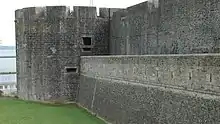Faussebraye
A faussebraye (Italian: falsa braga) is a defensive wall located outside the main walls of a fortification. It is of a lower height than the main walls, and is preceded by a ditch. In Greek and Byzantine fortifications, the faussebraye was known as a proteichisma.[1]

Faussebraye of Château de Brest
_in_1627_-_Intersection_of_the_defensive_works_of_Grol_in_1627_(Commelin%252C_1651).jpg.webp)
17th century illustration showing a cross-section of the fortifications of Groenlo. From left to right: counterscarp, covertway, ditch, faussebraye and the main defensive wall.
References
Wikimedia Commons has media related to Fausses braies.
- Spiteri, Stephen C. (2010). "Illustrated Glossary of Terms used in Military Architecture". ARX Supplement. MilitaryArchitecture.com: 9. Archived from the original on 25 October 2010.
This article is issued from Wikipedia. The text is licensed under Creative Commons - Attribution - Sharealike. Additional terms may apply for the media files.